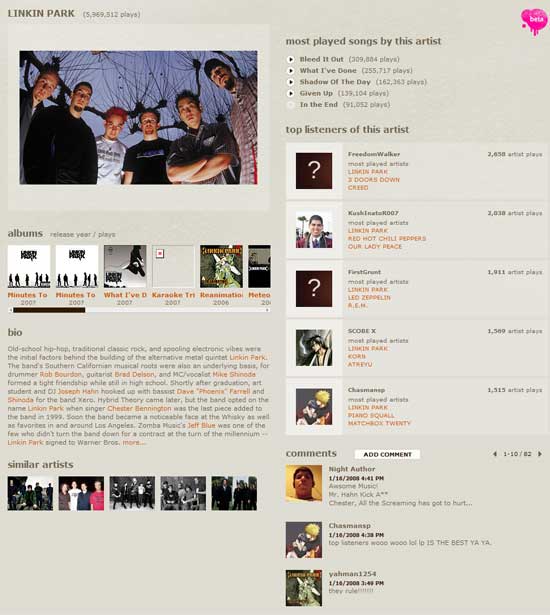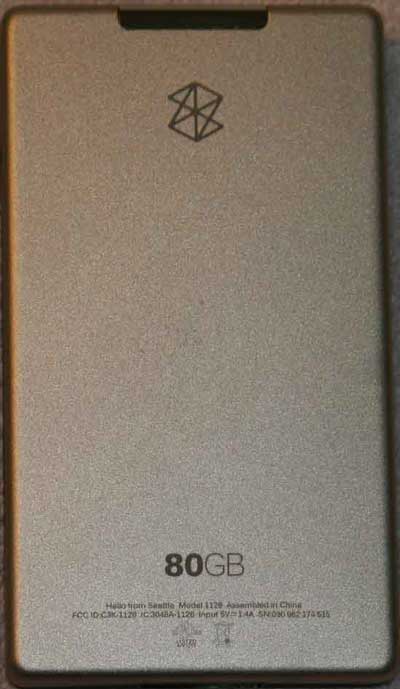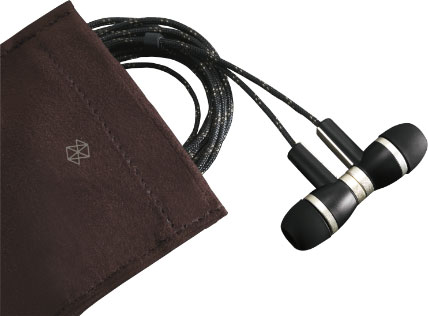iPod vs. Zune: January 2008 High End MP3 Player Roundup
by Ryan Smith on January 21, 2008 12:00 AM EST- Posted in
- Smartphones
- Mobile
Zune 80, Cont
Ultimately deciding on the value of the Zune comes down to how well it performs its tasks. When it comes to the Zune as a music player, the issues we have with it are minor in practice, and not the kind of showstopper issues that some people have had with the original Zune. Although with the presence of the larger screen you'd correctly assume Microsoft is focusing on more than just music here, Microsoft hasn't made the mistake of neglecting usability of Zune for music, and as such we're generally happy with it when it comes to playing music. If you're the kind of person that isn't bothered by the minor UI/control hang-ups, then you're going to find that the Zune is as easy to use and as effective as any other MP3 player we're looking at today.
On the technological side, we find that Microsoft's choice of format support is odd. On top of MP3 support it adds Microsoft's own WMA (lossy), WMA lossless, and is still one of the few players that supports the latest and greatest MPEG audio format, AAC. On the other hand it doesn't support WAV (admittedly useless, but still...) and audio book users will be disappointed to find out it doesn't support Audible, the de-facto source for audio books. Here the Zune joins the small club of only a few high-profile devices that don't support Audible's format, and this isn't something we'd expect. The Zune store has some audio books, but nothing comes close to Audible's collection at the moment. There's no Vorbis/FLAC support either, not that we'd expect it but it never hurts to mention how nice it would be.
There's also one final downside with the Zune here: there's no equalizer. This isn't a big deal for us personally, we don't find the need for the function on our MP3 players, but there's a good chance we're in the minority here. If you absolutely need an equalizer (although we digress and say you need better earbuds) then you're not going to want the Zune.
On the final upside however, the Zune does something Apple has avoided doing for the entire life of the iPod line and includes an FM radio tuner. Much like the equalizer, we don't see a need for FM radio since the audio quality is inherently inferior to a good audio file, but we can't find any faults in including it. FM tuners are small and easy on the power consumption, so for those users who for whatever reason want to be able to listen to the radio as easily as they listen to their other music, that option is open with the Zune.
Moving on, we have the video functionality of the Zune, one of the unit's real strong points in design. The UI for video is every bit as competent as it is for audio, which means Microsoft only needs to deliver on the hardware to make a solid combination. This is where Microsoft and Apple have diverged some, the iPod Classic isn't focused on video even though it has the ability, meanwhile the Zune is. The 3.2" 320x240 is big enough to be comfortable to watch videos on and it has no problem being bright enough to do so without any eye strain. We'll talk more about the screen later in our benchmarking section, but for now we'll say we're happy with it.
For the Zune 80 the technical side of its video abilities received a massive boost; the original Zune initially only supported Microsoft's WMV video, which for obvious reasons was a poor idea. This time around the Zune 80 supports MPEG-4 Simple Profile and H.264 along with WMV, with their associated standard-defined containers. Like the iPods it supports video resolutions in excess of the screen for compatibility purposes, but also like the iPods it's going to be a waste if you're encoding your own videos.
Finally, in sharp contrast to Apple's decision to add PIM functionality and games to the iPods to round out the devices, Microsoft has gone in a completely different direction with the Zune Social aspect of the device. For those not familiar with this functionality from the original Zune, as the Zune features a WiFi radio it has the ability to communicate with other Zunes in the immediate area. With this ability it can send songs (3 play limit), photos, and podcasts to other Zunes it sees. Microsoft's vision for this functionality is a (meatspace) community where users are sending each other songs, in effect helping each other find new songs by sharing what they like.
While we'd like to comment on the WiFi social aspect of the Zune, the lack of another Zune prevents us from doing so. We don't have another Zune in our possession and we haven't found another Zune (with its WiFi abilities turned on) to test this ability with, so we can only speak of it in theory. Our gut reaction is that this is a waste of battery power to leave the WiFi radio turned on (then again, perhaps we're not hip enough?) but we can't put our theory to the test to solidly judge it.
The other aspect of Zune Social, new with the Zune 80, is a social website approach to sharing music. Similar to MySpace and the like, users can create accounts, see what other people are listening to, and then make comments or recommendations about the music and purchase it for themselves if it's in the Zune store's catalog. We'll be frank here and say that we're not impressed with this aspect of it. Specialized communities are nice, but between the self-limiting issues of only being useful for discussing music and then only for Zune owners, and because there's already a flood of social networking sites, this comes across as very me-too of Microsoft. Since this isn't a feature of the Zune hardware there's nothing being drug down, it's just not a useful addition to the Zune experience.

Moving on to the design of the Zune, one of the major complaints about the original Zune was how big it was (.58" thick), a necessity for the larger screen, WiFi radio, and battery. The Zune has gone on a diet, and for the Zune 80 it's down to .50" thick. In this case we consider .50" the magic number for thickness; anything bigger is going to be too thick and will probably give us problems protruding if we aren't putting it in a baggy pocket, while .50" is just small enough that it passes our tests. It's still .09" thicker than the similarly designed 80GB iPod Classic, so for those absolutely worried about thickness but still want a hard drive, they may be turned off by the extra bulk.
Perfectionists sick of chrome backs on their MP3 players will be happy to find that the Zune uses a brushed aluminum back, which means it isn't the fingerprint or scratch magnet that is the iPod. The only downside to this is that it makes the Zune feel deceptively less-than-sturdy. The aluminum back is plenty strong, but on first picking it up it doesn't exude the same "this is a solid metal back" that the iPods do. On the whole the Zune 80 is every bit as solid of a design as the rest of the MP3 players we're looking at today; we don't have any concerns with it breaking.

Wrapping things up, we have the grab bag of everything else that doesn't fit in to another category. We'll start with earbuds, a sore subject for us when it comes to the iPods. With the Zune, Microsoft clearly gets the idea that users don't want to or won't purchase separate earbuds for their MP3 player, as they include a set of remarkable "premium" earbuds with the Zune 80. Not only is the audio quality of these earbuds immediately superior to that of the iPod earbuds, but these are in a canalphone style using rubber fittings to hold the earbuds to the ear. This blocks out some outside noise and does a great deal to keep the earbuds inside of your ears, our biggest problem with the iPod earbuds. Audiophiles still won't be impressed but otherwise these are great earbuds that most users won't feel the need to replace, and a solid example of the kind of earbuds that should be coming with a high-end MP3 player.

On a less positive note, we're disappointed with how the Zune is interfaced with a host computer. Like the iPod Touch, it's a device that requires a driver to be recognized by the operating system and used, which brings about the same OS-agnostic problems as with the Touch. Microsoft had the sense to support 64bit versions of Windows out of the box, but not Linux or the Mac. It would behoove Microsoft to get the Zune working on the Mac as Apple's market share continues to grow (particularly with laptops).
Unfortunately the driver issues also means that the Zune can't immediately be used as a portable hard drive, which is a much bigger deal for the Zune than it was for the much smaller Touch. An 80GB hard drive is huge, using a MP3 player with such great capacity as a portable hard drive is something that you'll never find on a spec sheet but is something we believe many owners are definitely going to want to do. While we can use a registry hack to enable disk mode, we still need the driver installed and the registry edited on each computer we want to interface the Zune with; it's a very impractical solution. The Zune should have a native USB mass storage device mode like the iPod (even if drivers would still be required to do anything else with the Zune), it's appalling that it lacks this.
Last, we feel Microsoft is really failing to grasp what they can do with WiFi here, even more than Apple with the Touch. We're absolutely thrilled that we can wirelessly sync the Zune, and we're absolutely confused as to why that and media sharing are all we can do. Since the Zune isn't built with the kind of controls or the kind of hardware needed to be a full PDA we aren't expecting a lot, but it has FM radio support but no internet radio support? And what about wireless access to the Zune social service or the Zune marketplace? Even though Apple now has a product with WiFi support this still could be something that could help further set apart the Zune from the iPod Classic, but Microsoft missed their chance here.










50 Comments
View All Comments
cmdrdredd - Monday, January 21, 2008 - link
The Zune skips and pops? when? prove that to me? hell even the iPod doesn't skip or pop...that's in your recording and your piss poor 128kbps limewire bootleg downloads.Odeen - Monday, January 21, 2008 - link
I am referring to Zune and iPod's inability to seamlessly transition from one song to the next (such as for a live concert recording, classical music, or a techno mix album).Since MP3's are composed of a fixed number of "frames" of approximately 418 bytes, any song has some amount of silence at the last frame. The Karma detects this silence and begins to decode the next track in the playlist before the previous track ends. As a result, the seamless transition from the CD (or live) source is preserved.
On the other hand, the iPod and Zune dumbly play the ENTIRE mp3 file. The sudden transition to silence, and beginning to play again sounds like a "pop". It has nothing to do with the bitrate or source of mp3 files.
Other file formats, like OGG and FLAC have metadata that tell the player the exact length of the recording. As a result, the player doesn't have to analyze the file for trailing silence, and this works even better in eliminating gaps. However, without 3rd party hacks, the iPod and Zune can't play those file formats either.
http://www.pretentiousname.com/mp3players/">http://www.pretentiousname.com/mp3players/
Tegeril - Tuesday, January 22, 2008 - link
Perhaps you haven't used an iPod in a while, but the gapless playback feature works perfectly. Please try again.Odeen - Tuesday, January 22, 2008 - link
It works for recent MP3's with proper song length metadata.It doesn't work for older MP3's without that information. The Karma can still play the older MP3's gaplessly by actually analyzing the audio data, whereas the iPod needs to have the song length tags spoon-fed to it.
Roffles - Monday, January 21, 2008 - link
I currently own a Zune80. Although I watched an episode of "Curb Your Enthusiasm" at lunch today, I use it 90% for listening to music.All these gimmicky features with new mp3 players are nice, but this review (and the designers of Zune and Ipod) lost focus of what an MP3 player is all about. It's about listening to mp3's right?
The main factors that should decide which player is best are:
1. GUI responsiveness, GUI design and GUI navigation.
2. Audio fidelity and customization.
3. Battery life
4. A higher level of customization
Everything else should be a distant second as they are the features more akin to PMP (personal media players). If it were not for the 80GB drive size, I would have stayed with a tried and true Korean mp3 player from Iriver or Cowon.
I would rather compare the Zune to my Cowon i7 and a2 as far as features are concerned. The Zune is a major firmware update away from being the ultimate mp3 player.
1. Cowon gives me a graphic equalizer (custom and several presets)
and lots of audio tweaking options such as jeteffect, BBE, Mach3Bass, MP Enhance, 3D surround, Pan and Play speed.
2. Cowon gives me more shuffle options
3. Cowon gives me a sleep timer and a wakeup timer so I can lullabye myself into an afternoon nap if I choose.
4. Cowon lets me customize text scroll speeds and other gui enhancements.
5. Cowon also gives me an FM player, and then lets me record FM radio with custom bit rates.
6. Cowon gives me a voice recorder with custom bit rates
7. Cowon gives me a text viewer
8. Cowon lets me adjust scan speed (good for very long recorded talk shows or joined albums and mixes that can be hours long)
9. Cowon gives me the option to use id3 tag browsing or filename browsing
All these options with exception to a few of the obvious ones on the list make listening to mp3's easier and more enjoyable...hence making it a better mp3 player.
There are DOZENS of other smaller tweaks and customization that I won't bother getting into, but I hope I'm making a good point here. Also, the audio output (power and fidelity at normal equalization) is amazing compared to anything I've heard from an Ipod or Zune.
VashHT - Thursday, January 31, 2008 - link
I have thought about replacing my Cowon X5 for a while, the mainr eason I won't buy an Ipod is because I don't want to use itunes or reformat all of my music into itunes format. One thing that I hate about all of these mainstream playes is they won't support .wav files. I back up all of my CD's in .wav format on my PC, and with my X5 I can just put them on there and not worry about converting anything. Sure the extra fidelity is pretty much lost when using most earbuds or headphones, but if I use the AUX output to hook them up to speakers or use decent headphones with it then the wav files obviously sound a lot better. Also with 80Gb of space or more the much larger file size of wav files becomes practically a non-point. Also, besides wav it supports a lot of other open formats, and for compressed format I would much rather use OGG than mp3.Ripvanwinkle - Tuesday, January 22, 2008 - link
Cowon all the way! My only complaint with my D2 is that itrefuses to make my coffee in the morning.
ThePooBurner - Monday, January 21, 2008 - link
How can you do a High End MP3 player round up and not include the Creative Zen series? A Player that is technologically superior to both the Icrap and the Zripoff? That is all.Ryan Smith - Monday, January 21, 2008 - link
I actually agree with you on the matter. We wanted to include a Zen and a couple other players, but we weren't able to acquire anything more than what we have today. As is the case when you're relaunching some kind of product coverage, we hope we'll be able to get players from additional vendors for future articles.michael2k - Monday, January 21, 2008 - link
How do you define "technologically superior"? The UI of the iPod (with the scrollwheel) can be seen as technologically superior (at least since it's introduction in 2001), though you can argue that since 2004 with the introduction of the Zen that Creative caught up. The hard drive of the iPod (which has been 1.8" since 2001) can also be noted as technologically superior, though again Creative caught up with their 2004 Zen Micro and Zen 1" and 1.8" products.Then there is battery life and size... If you want to claim Creative Zen is technologically superior, fine, but there are multiple facets to superiority here.